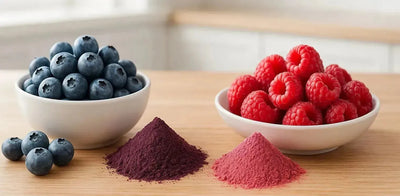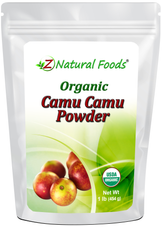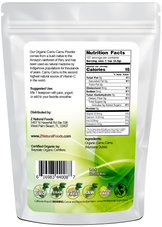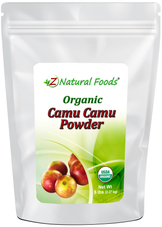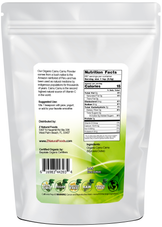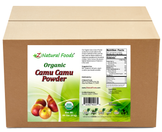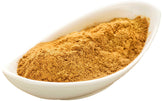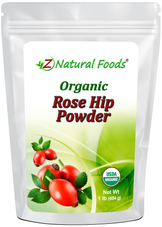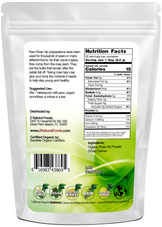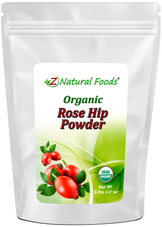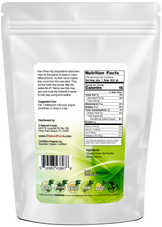Description
Description
Congratulations! You made it to week four of our five-part New Year’s series, which discusses the top five foods and herbs that nourish the immune system.
In 2024, Z Natural Foods created some incredible products and educational resources to support your healthy aging goals.
We also hope that in the year 2100, as you ride your spaceship to work drinking a cup of our mushroom coffee with some vitality creamer, you will look back and remember that Z Natural Foods got you there.
We have decided to start this new year with a five-part series about foods and herbs that support and nourish a healthy immune system response in their own unique ways. As you probably know by now, in this series, we discuss each food and herb's nourishing properties, potential mechanisms of action, and the best way to use them.
As we get started, we invite you to review our year-end article reviewing excellent topics on setting your natural food and wellness goals for the new year:
How to set your natural food and wellness goals for the new year
Also, to review the first three articles in this series about supporting a healthy immune system, go here:
Part four of this series will discuss two of the most incredible whole food sources of Vitamin C; the Camu berry and Rose hips.
Before we begin, it is essential to understand a few critical points:
-
The part of the plant used is vital when determining the action we seek from that plant.
-
Many medicinal plants have parts that can be used as individual entities for acute and chronic illness stages, especially when combined with other supportive herbs.
-
When both parts are combined and used as a whole herb, the same herb can take on a tonic role.
-
Sometimes, determining whether a substance is used as a medicinal or tonic is as simple as selecting the dosage and frequency.
The herb echinacea is an excellent example of how to use the different parts of the plant to support specific pathway responses:
-
The root is more concentrated in alkylamines, possibly supporting a healthy inflammation response. It is best for the acute stages and is often used in high amounts for short durations. Combining it with elderberry, ginger, and Andrographis will further support that response.
-
The ariel (above-ground) portion is more concentrated in lipoproteins and polysaccharides. When taken in small quantities over an extended period, these substances are known to stimulate and strengthen the constitutional response. Combined with maitake mushrooms and Astragalus, they further nourish that response.
Two Incredible whole foods that contain the “Complete Vitamin C Complex"
Unless you have lived under a rock for the past 50 years, you probably know about all the nourishing benefits of consuming supplements or foods high in vitamin C, especially when consumed in a whole food matrix.
You may notice a wide array of Vitamin C products as you search online or in the isles of a health store. Most of them will present as an isolated version of this nutrient, with other added compounds (like a buffered version containing ascorbic acid and the minerals calcium, magnesium, and potassium) to make it more tolerable by the digestive system.
Other products present a mixture of foods that provide a whole-food matrix of compounds so the human body can get the most nourishment from them.
Rosehips and camu berries are some of the few foods considered to contain the complete “Vitamin C Complex” because they provide high levels of Vitamin C and a full array of supporting compounds.
The complex also includes a tremendous diversity of polyphenolic compounds, providing superior nourishment.
There is a lot of confusion and misinformation about all the various forms presented in Vitamin C supplements (Ascorbic Acid, Buffered, Liposomal, and Ascorbyl palmitate) regarding absorption, plasma levels, and bioavailability.
So, let’s get some clarity on this topic:
-
All Vitamin C, aka L Ascorbic Acid, derived from a whole food matrix or synthetic sources, are chemically identical with no known differences in biological activity.
-
Buffered (with minerals), liposomal (encased in fat), and ascorbyl palmitate (both fat- and water-soluble components) provide no extra benefit specifically to the utilization of Vitamin C other than being slightly less acidic in the digestive system.
-
Ascorbyl Palmitate contains water and fat-soluble components, but the digestive system essentially strips away the fat-soluble part to derive the pure ascorbic acid.
The research on this specific topic shows proof on both ends of the spectrum.
A review titled Synthetic or Food-Derived Vitamin C- Are they equally Bioavailable? stated, “All steady-state comparative bioavailability studies in humans have shown no differences between synthetic and natural vitamin C, regardless of the subject population, study design, or intervention used. Some human pharmacokinetic studies have shown transient and small comparative differences between synthetic and natural vitamin C, although these differences will likely have minimal physiological impact. Study design issues and future research directions are discussed.”
The following was stated in a paper by the National Institutes of Health regarding Vitamin C and its effect on the immune system:
-
Vitamin C appears to exert many beneficial effects on the cellular functions of the innate and adaptive immune systems.
-
Vitamin C is a potent antioxidant that protects the body against endogenous and exogenous oxidative challenges.
-
Its action as a cofactor for numerous biosynthetic and gene regulatory enzymes likely plays a key role in its immune-modulating effects.
-
Vitamin C stimulates neutrophil migration to an infection site and enhances phagocytosis, oxidant generation, and microbial killing.
-
It protects host tissue from excessive damage by enhancing neutrophil apoptosis and clearance by macrophages and decreasing neutrophil necrosis and NETosis.
-
Thus, vitamin C is necessary for the immune system to mount and sustain an adequate response against pathogens while avoiding excessive damage to the host.
The whole food provides a better result than isolated nutrients
However, research over the last 50 years has taught us that while isolated nutrients and standardized compounds are adequate when targeting specific mechanisms of action, they present significant challenges and pitfalls. Those pitfalls occur because essential components are missing for a balanced and harmonious result.
For example, you can mix isolated ascorbic acid and bioflavonoids, hoping they will provide optimal levels of Vitamin C. Numerous isolated compounds may produce significant plasma levels of ascorbic acid and get the job done. However, they will never give the same nourishment as a whole-food matrix.
Finally, let’s not forget that one of the missing links often overlooked when supporting healthy collagen levels is foods with high vitamin C levels. There is a clear connection between vitamin C and its effect on collagen synthesis. Without vitamin C, the body can’t form collagen. Simply, it acts as a glue to bind collagen fibers together.
A preliminary in vitro study of vitamin C's effects on collagen synthesis discovered that “vitamin C plays a crucial role in maintaining a normal mature collagen network in humans by preventing the auto-inactivation of two key enzymes in collagen biosynthesis.” It was also shown that vitamin C induces a dose-dependent increase in type I collagen deposits by normal human fibroblasts.
Camu Berry
A miraculous food found in the rainforests of Brazil and Peru, camu berries are the tart and tangy powerhouse holding their own in the world of berry nourishment. This unique berry has a flavor profile, creating a second-to-none complexity that allows for and contributes to its potentially limitless applications. World famous for its high nourishing levels of Vitamin C (3.5 grams per 100 grams), camu berries provide a unique whole-food complexity to what is often tossed aside as a simple isolated nutrient.
Endorsed by the late, great USDA ethnobotanist Dr. James Duke for its tremendous and complex nourishing qualities, this powerhouse berry with an ORAC score of around 52,000 offers much more than high levels of vitamin C, namely flavonoids. Many health experts believe a diet focused on high amounts of flavonoids is critical to supporting a healthy aging process because these compounds are known as nature’s biological response modifiers.
There are over 8,000 different types of flavonoids found in nature. Polyphenols are a term used to describe a general category of compounds found in a broad spectrum of fruits, vegetables, and tea that work as “reducing agents” along with other compounds known as antioxidants to support a healthy inflammation response and the body's ability to protect and repair damaged tissue caused by oxidative stress. While over 8,000 polyphenols have been identified, some of the most common are flavonoids, flavonols, and anthocyanins. The importance of discussing these various compounds allows you to more clearly understand the wide range and complexity of nourishment you are getting from these powerful foods.
Let’s take a look at what some of the research says about Camu’s potential various mechanisms of action.
The following was stated in a randomized control trial of twenty male smokers considered to have an accelerated oxidative stress state to determine the antioxidative and anti-inflammatory effects of Camu berry. The individuals were randomly assigned to take 70 ml of 100% camu-camu juice (corresponding to 1050 mg of vitamin C) or 1050 mg of vitamin C tablets daily for 7 days. “Oxidative stress markers such as the levels of urinary 8-hydroxy-deoxyguanosine (P<0.05) and total reactive oxygen species (P<0.01) and inflammatory markers such as serum levels of high sensitivity C reactive protein (P<0.05), interleukin (IL)-6 (P<0.05), and IL-8 (P<0.01) decreased significantly in the camu-camu group, while there was no change in the vitamin C group.”
Therefore, the following was concluded. “Camu-camu juice may have powerful anti-oxidative and anti-inflammatory properties, compared to vitamin C tablets containing equivalent vitamin C content. These effects may be due to the existence of unknown anti-oxidant substances besides vitamin C or unknown substances modulating in vivo vitamin C kinetics in camu-camu.”
Rosehips
Known for its place as a powerful bioflavinoid and the vice president of the typical old-school vitamin C formulas, it may surprise you that rose hips are also a potent source of Vitamin C. According to the USDA, 100 grams of rosehip contains 426 milligrams of Vitamin C. While this number is impressive, it is dwarfed by the king of vitamin C, the camu berry. However, rosehips tied for second place, with some other remarkable berries solidifying its place on the winner's podium.
Rosehips are also considered a powerful survival food as they grow wild in Alaska and are a staple among Alaskans during the dark, harsh, cold winters. While the red/orange variety is most typical, it is not uncommon to see the yellow and black varieties. Rosehips are a very versatile food that can also be used in tea and soups and to make preserves. Like many plant foods that are excellent sources of various polyphenols, rosehips get their beautiful color from carotenoid pigments, specifically lycopene. While lycopene is most well-known for being the superstar compound found in tomatoes (averaging 4-5 milligrams per 100 grams), raw, fresh rosehips, on average, contain 25 milligrams per 100 grams.
Finally, another pleasant surprise is that rosehips have been shown to support a healthy inflammation response. Research indicates that rosehips work in the following way:
-
The reduction of pro-inflammatory cytokines and chemokines
-
The decrease in NF-kB signaling
-
The inhibition of pro-inflammatory enzymes, including COX1/2, 5-LOX, and iNOS
-
The reduction of C-reactive protein levels
-
The reduction of chemotaxis and chemoluminescence of PMNs
-
The inhibition of pro-inflammatory metalloproteases
A preliminary study examining the biological activities of selected polyphenol-rich fruits (rosehip, chokeberry, hawthorn, blackcurrant, blueberry, and rowanberries) related to immunity and gastrointestinal health for their effect on the production of reactive oxygen species (ROS) by phagocytes, antimicrobial properties against 11 human pathogens stated the following:
-
Rosehip extract showed the highest antioxidant activity via ORAC, TRAP, and HORAC assays.
-
Blueberry extract was the most potent inhibitor of lipid peroxidation.
-
All extracts inhibited ROS production in opsonized zymosan-activated phagocytes, indicating that they interfere with the signaling cascade of phagocyte activation upstream of protein kinase C activation.
-
Chokeberry, blackcurrant, and rowanberry extracts revealed strong antimicrobial properties against a broad spectrum of microorganisms and had the highest mitogenic activity.
Based on the research and what we currently know, Camu berries and Rosehips primarily support the immune system via their effect on the inflammation cascade, and due to their high vitamin C content, they directly impact the following.
-
Cellular functions of the innate and adaptive immune systems
-
Actions as a cofactor for numerous biosynthetic and gene regulatory enzymes likely play a key role in its immune-modulating effects
-
Stimulates neutrophil migration to an infection site and enhances phagocytosis, oxidant generation, and microbial killing
-
Protects host tissue from excessive damage by enhancing neutrophil apoptosis
In conclusion, these two potent foods can and should be used daily to nourish the immune system. They are not necessarily specific to an acute response. Still, their nutrient density allows them to provide consistent nourishment to keep our immune systems in check and keep us strong and healthy.
However, slowly increasing your consumption during times of distress will simply further nourish a potential healthy immune and inflammation response from your body.
For more information about our Organic Camu Camu Powder, go here:
For more information about our Organic Rose Hip Powder, go here:
To review all of our Fruit Powders, go here:
The Author’s Bio
Michael Stuchiner is a Master Herbalist and proud graduate of The School of Natural Healing and has worked in different areas of this field for over 25 years. He is a retired elite-level powerlifter who competed for 27 years. As an avid international traveler, he is passionate about the use of medicinal and tonic herbs, as well as foods traditionally found in local markets in the 35 countries he has visited. Michael brings you his years of experience as a Master Herbalist, traveler, and athlete through the hundreds of articles he has written and his YouTube channel (A Master Herbalist Perspective). He is considered a true educator in this field. For more articles written by Mike, go here: Master Herbalist.
